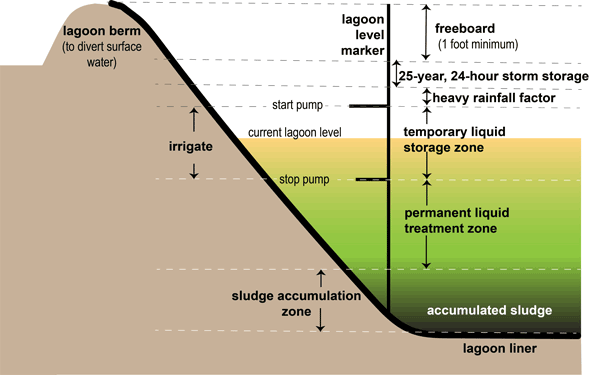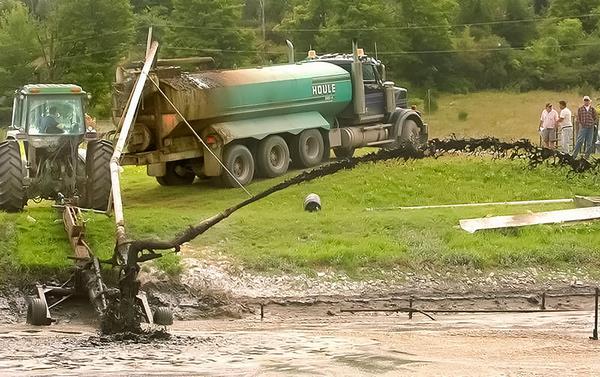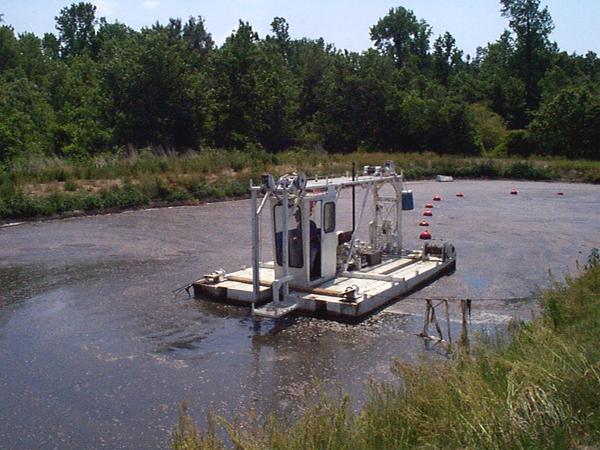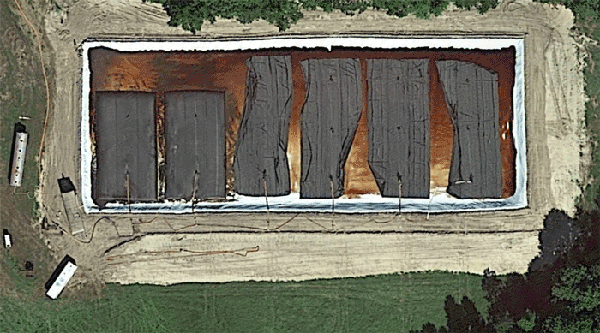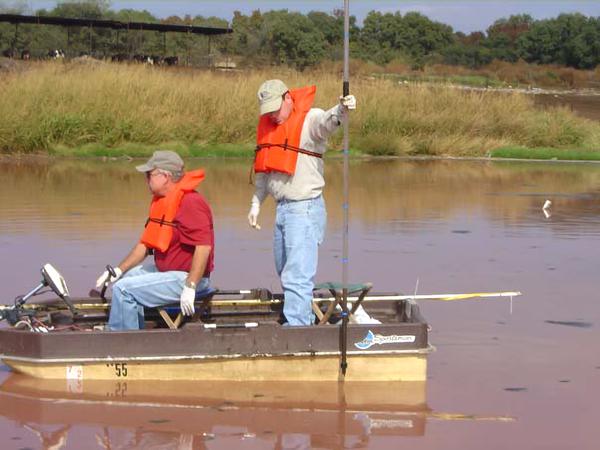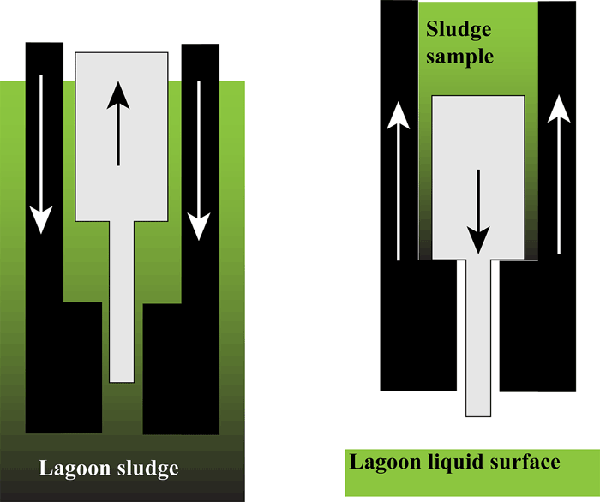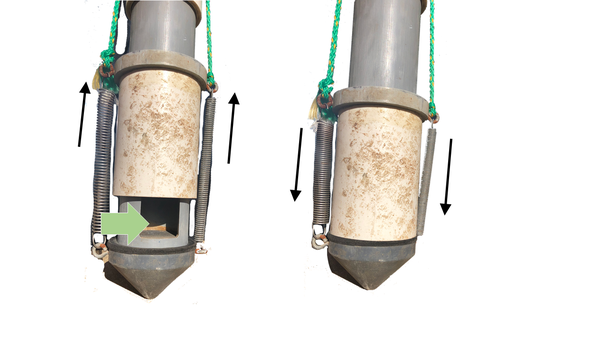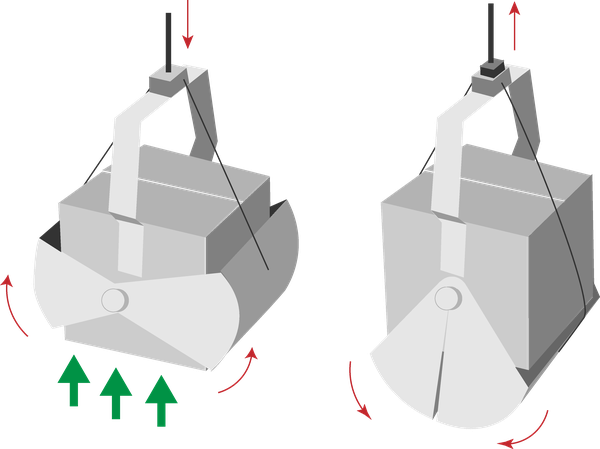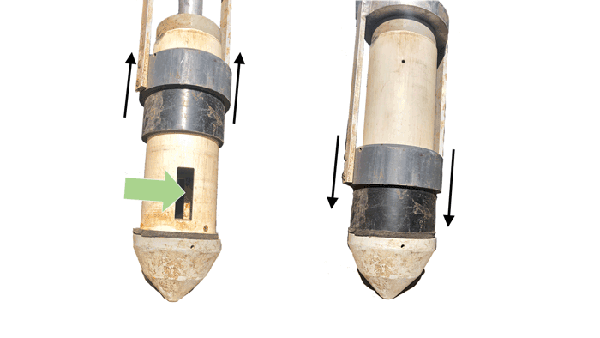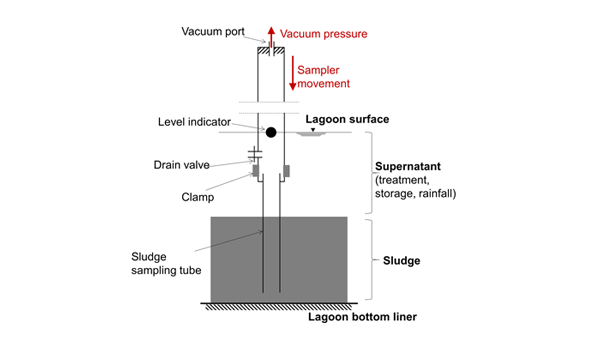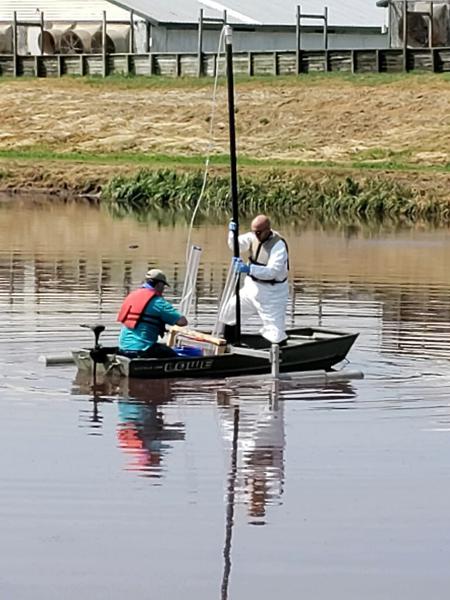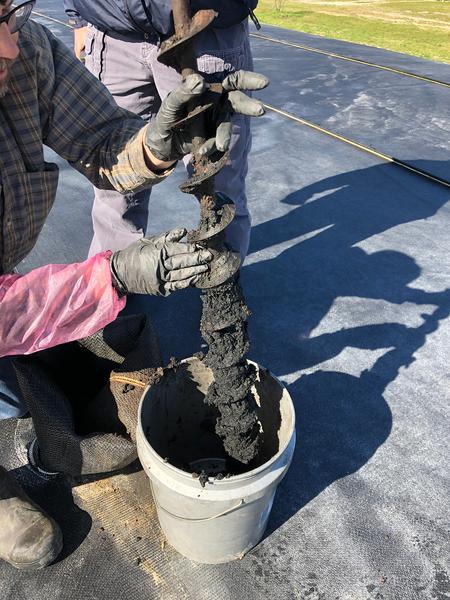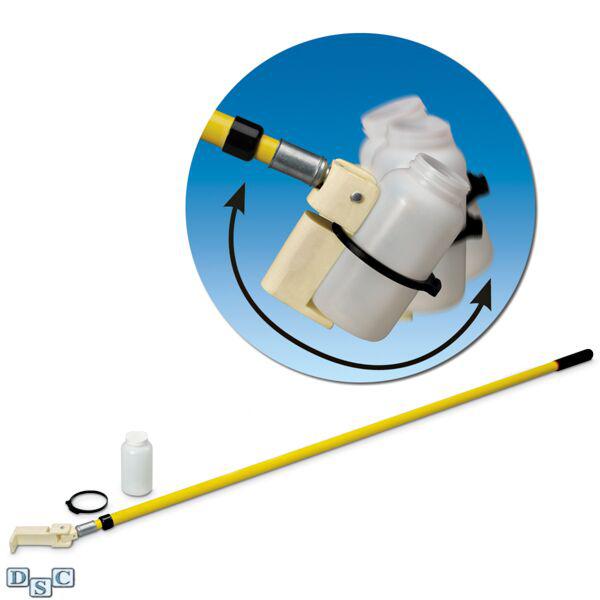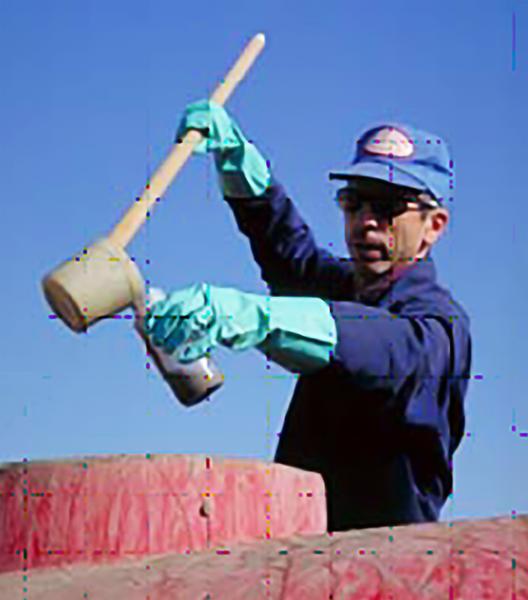Introduction
Anaerobic swine lagoons are earthen structures used in the southeastern United States to store and treat swine manure on the farm (Figure 1). Lagoon treatment relies on anaerobic bacteria to break down organic matter in manure, which reduces odor and solid content and makes liquid manure (supernatant) easier to manage. While effective in reducing manure solids, anaerobic treatment leads to the slow accumulation of a residue rich in solids and nutrients (sludge). Sludge consists of dead bacterial cells, digested residue, and inert material that cannot be degraded in the lagoon. If left to build up, sludge will reduce the lagoon treatment volume (Figure 1), which reduces the treatment efficiency and leads to objectionable odor emissions. Because settling solids (sludge) are already a phosphorus-rich residue, these become even more challenging to manage agronomically when they accumulate in the lagoon. The concentration of nutrients and solids in the manure liquid also increases with sludge buildup, which will lead to salt deposits, blockage, and corrosion in manure irrigation systems.
Sludge can be removed by agitating the lagoon and pumping the suspended sludge mixture into manure tankers for direct land application (Figure 2). Alternatively, the sludge can be removed using a floating dredge (Figure 3) and mixed with a polymer before being pumped for temporary storage into permeable bags (referred to as geotextile bags) (Figure 4). The latter option allows polymer-treated sludge to leach out liquid during storage, which reduces the tonnage of sludge to be transported and land-applied and reduces overall cost of land application. Recently, the use of excavators for routine sludge removal has become more common. These excavators are often used to harvest sludge for further drying in greenhouses or covered bays (Figure 5).
Monitoring the amount of sludge in the lagoon and collecting samples for analysis are required for lagoon management, regardless of the method of sludge removal and utilization. This factsheet focuses on the lagoon sludge sampling considerations and methods.
Why Is Sludge Sampling Necessary?
Lagoon sludge sampling allows operators to determine nutrient concentration in the sludge through laboratory analysis. Sludge analysis results are essential to developing nutrient management plans that utilize the sludge beneficially without harming soils, crops, or surface water and groundwater. Sludge sampling also helps monitor the performance of the lagoon and measures its treatment effectiveness, particularly after sludge removal or the introduction of a lagoon additive (enzymes or bacteria). At lagoon closure (decommissioning), producers are required to develop utilization plans for the lagoon sludge in accordance with the N.C. Swine Waste Management System General Permit (North Carolina Department of Environmental Quality 2019) using the Natural Resources Conservation Service Code 360 Waste Facility Closure Conservation Practice Standard, which requires comprehensive sludge sampling. Composition of lagoon sludge varies widely among lagoons and within the same lagoon, so operators are required to rely on sampling instead of book values to develop sludge utilization plans.
Sludge is often sampled before removal from the lagoon.
Choosing where to collect sludge samples from the lagoon depends on sludge management goals. For example, if sludge will be removed as part of regular lagoon operations, the upper sludge zone in the lagoon will be sampled because that is the portion typically removed during agitation and pumping. On the other hand, if the lagoon is being decommissioned, a sample of the complete sludge profile is required because all sludge residue will have to be removed and utilized. The nutrient analysis of these samples, along with the volume of sludge to be removed, provides an estimate of the amount and concentration of nutrients that will be land-applied. This information helps crop specialists determine acreage, crops, and application rates for utilizing the sludge nutrients while minimizing the risk of high soil index of phosphorus (P), zinc (Zn), or copper (Cu).
Sludge is also sampled from the slurry-loaded tanker/applicator before hauling for land application.
While lagoon sludge samples provide values for use in planning application, tanker samples provide values of nutrients actually applied to fields. The composition of agitated/pumped sludge can vary significantly during the start, middle, and end of the removal process due to variations in water content and density of the solids; sampling each tanker is recommended to capture this variability. Analysis results from samples taken from a tanker on its way to land application will not be available until the sludge has already been applied. Collecting sludge samples from the lagoon is critical for avoiding excessive nutrient application (overapplication). In cases in which overapplication has occurred, notify a crop specialist to seek assistance or corrective action to mitigate impacts of overapplication (for more information, visit the North Carolina State University Department of Crop and Soil Sciences Nutrient Management Program website). Corrective actions include turning the soil, adding lime, or changing crop rotations on these fields.
Sludge may also be sampled from geotextile bags.
Sludge sampling from geotextile bags provides a more reliable estimate of the sludge nutrient concentration than lagoon sampling. In addition, because the bags are stored on site until use, the sampling analysis results will be available to help plan nutrient application. Due to its low water content, bagged sludge typically contains higher nutrient concentrations per ton. This makes sludge transportation cheaper on a per-ton basis, but operators may find it more challenging to identify crop fields large enough to safely utilize all of the nutrients. It may be necessary to reduce application rates to minimize any negative impacts of high nutrient concentrations.
The following sections provide details and recommendations on tools that can be used to sample sludge from lagoons, geotextile bags, and manure haulers.
Sludge Sampling in the Lagoon
Sampling lagoon sludge requires using a small boat (for example, a johnboat) with oars or a battery-operated propeller. Note that propellers can get stuck in high-solids zones of the lagoon, particularly near the banks, so oars or a pole will be needed to manually dislodge the boat. For sludge sampling or surveying, you will need boat anchors, ideally two or three, to ensure that the boat remains in position during surveying and sampling. You can use stakes on both sides of the lagoon with a connecting thread to help sample along lines in the lagoon.
Using a boat in a manure lagoon is a risky activity and requires following safety recommendations:
- Any person within the lagoon berm (whether in the boat or at the lagoon bank) must wear a flotation vest.
- At least one person must be present on the lagoon bank with a throwable flotation device connected to a line and a charged cell phone with reception to request emergency assistance if needed.
- Samplers must wear boots and gloves to minimize contact with manure.
Sludge sampling requires a tool to collect sludge from beneath supernatant and treatment zones in the lagoon and a bucket to combine collected samples.
The following sections review different sampling and collection tools and their advantages and limitations.
I. Sludge Judge Sampler
Sludge Judge is a brand name for a clear PVC tube (3⁄4 inch to 11⁄2 inch diameter) with a one-way valve to determine the level of sludge in treatment tanks, ponds, and lagoons. The Judge consists of multiple 3-foot segments that connect to form a 15-foot sampler (Figure 6). The one-way valve at the end of the Judge ensures sample flow in one direction. The valve is open when the sampler is lowered into the liquid and closes once the sampler is lifted. Figure 7 shows the valve positions during sampling and recovery from the lagoon. This sampler costs between $50 and $150.
Advantages:
- It is easily transported and assembled in the boat.
- It provides a visual representation of the interface between supernatant and sludge layers in the lagoon.
Limitations:
- The sampler diameter can make sample recovery a challenge. We recommend using a sampler with a diameter of at least 1 inch.
- High solids in the sludge can keep the valve stuck open during removal from the lagoon, leading to sample loss. To overcome this issue, some operators have modified this sampler by using a rope to manually close the valve before recovering the sampler from the lagoon.
II. Kroes-Barth-Dodd (KBD) Sampler
This sludge sampler was developed specifically to collect 1-liter manure samples from animal waste lagoons from as deep as 10 feet (Kroes et al. 1987). This sampler consists of a long plastic rod connected to a sampling chamber (up to 1 liter in volume) fitted with a spring-loaded sliding gate. Two long ropes are used to control the spring-loaded gate from the sampling boat; this allows the sampler to be deployed into the lagoon while the sampling chamber is closed until desired depth is reached. Figure 8 shows the sampling chamber during sampling (open) and after release of the chamber springs (closed). Using this sampler, the operator can collect multiple samples at different depths in the lagoon to composite or analyze separately. We recommend using sludge depth survey data to determine sampling depths and get a representative analysis of the lagoon sludge composition.
Advantages:
- It is useful for collecting depth-specific samples from the lagoon.
- Handling and transfer of samples are easier, particularly in a small boat.
Limitation:
- Because sludge is highly viscous, the gate can become stuck open, risking sample loss or mixing with lagoon water. To overcome this limitation, clean the springs after each use and inspect to ensure proper operation.
III. Ekman Dredge Sampler
This sampler, also referred to as a clamshell dredge, was developed to collect (dredge) sediments in lakes and rivers (Ekman 1911). It consists of a metal chamber with spring-loaded clamshell doors (Figure 9) connected to a long rope and fitted with a sliding weight along that rope. Sampling is accomplished by first lowering the sampler, in the open position, into the lagoon until it settles in the sludge layer. Before pulling the sampler out of the lagoon, the weight is dropped to trigger the spring-loaded gate and close the chamber doors, capturing the sludge sample. The sampler is then withdrawn, using the rope, back to the boat, where the sludge sample is transferred into the sampling bucket.
Advantage:
- It is easy to transport, load, and unload from the sampling boat.
Limitations:
- Sampling depth depends on weight of sampler and speed of lowering and removing from sludge.
- Spring mechanism may jam, particularly in thicker sludge, leading to sample loss during removal.
- Partially closed sampler can dilute sludge sample with supernatant, which biases analysis results.
IV. NC State Sludge Sampler #1
NC State researchers developed the NC State Sludge Sampler #1 (Figure 10) to collect sludge samples at specific depths in the lagoon (Classen et al. 2011). This sampler is similar to the KBD sampler; however, it uses a mechanical sliding gate to open and close two gates in the sampling chamber.
Advantage:
- The chamber gate is manually controlled, which eliminates risk of jamming and sample loss.
Limitation:
- The sampler is bulky and can be a challenge to deploy and remove, particularly in a small boat.
V. NC State Sludge Sampler #2
NC State researchers developed this sampler to retrieve intact sludge profile samples (Sharara et al. 2019). It consists of two clear PVC pipes (each is 2 inches in diameter) connected by a clamp and equipped with a drain valve. Using this sampler, an entire lagoon column can be captured with the choice to drain off the supernatant section using the drain valve. This sampler uses a small vacuum pump and a floating level indicator (Figure 11a and Figure 11b) to ensure it captures the movable sludge phase instead of pushing it as the sampler is lowered. The dense solids and liner at the lagoon bottom act as a cap to the collected sludge column. After retrieval of the sampler, the supernatant can be drained off and the clamp unhooked to capture the sludge sample column.
The sludge sample is mixed with other samples either on the boat or retrieved intact for later analysis.
VI. Steel Tube Sampler
This sampler consists of a steel cylinder chamber with a hinged gate (Figure 12). The gate allows the recovery of sludge after sampling. This sampler uses the dense sludge and lagoon liner as a cap to prevent sample loss during recovery.
Advantages:
- It recovers a continuous sludge column, which is representative especially in lagoon closure planning.
- It is easier to recover the sampled sludge.
Limitations:
- Sampling multiple cores is time-consuming.
- More space is needed than that available on a johnboat.
- The sampling device is heavy.
Sludge Sampling From Geotextile Bags
In North Carolina, many swine producers rely on permeable geotextile bags (geo-bags) to concentrate sludge solids through polymer-assisted dewatering. After the dewatering process step is completed, the sludge in the geo-bags is typically at total solid (TS) concentration of 20%. It is typically land-applied with a manure spreader used for applying poultry litter and compost.
Sludge bags should be sampled after liquid leaching has stopped. Samples can be collected from the bag using built-in ports (1-foot diameter) originally used to fill the sludge bags or by cutting an opening in the fabric to sample sludge. If the sludge will not be land-applied soon, add a cover (tarpaulin or plastic sheet) over sampling holes in the bag to prevent bag degradation.
While many users reach through the ports to grab samples by hand, we recommend using a long implement to collect multiple sludge samples from deeper inside the bag. This is because over time, the outer layer of bagged sludge dries out, while the internal volume remains wet. Analyzing dried sludge samples provides an overestimation of nutrient concentration in the bag. Deep samples, on the other hand, combine wet and dry sludge, which provides better representation of the bagged sludge and improves accuracy of nutrient content estimation. A potential collection tool is an auger that can be fitted into a portable power tool. The operator can drive the auger into the bagged sludge to the recommended depth of 2 to 3 feet, then manually remove the auger with the sample (Figure 13). Collect multiple samples (five to eight) from different spots on each bag, then combine and mix the samples thoroughly to create a homogenous, representative sludge sample. Use clearly labeled jars (16 ounce or larger) or sealable plastic bags to store the samples for analysis. Avoid leaving the sample at room temperature or in direct sunlight, which can significantly change nutrient concentration. Plan to send sludge samples to the laboratory for analysis immediately after sampling; otherwise, freeze samples until they are ready to send.
Sludge Sampling From Tanker / Hauler
Using the previously described lagoon sampling tools facilitates estimating the amounts of sludge nutrients that are available. To quantify exactly how much gets applied, the pumped sludge needs to be sampled from the loaded tanker. In these situations, sludge contains TS between 4% and 8% and therefore is typically handled as a slurry. You can sample sludge from the tanker using a swing sampler, which consists of a telescopic arm connected to a bracket to which a sampling bottle is attached (Figure 14). Swing samplers cost between $100 and $200 and can be used to sample slurry from tankers and lagoon liquid (supernatant). You can build a swing sampler by affixing a sampling container to a long pole (Figure 15). We recommend using a wide-mouth jar or bucket when sampling slurry to capture a representative mixture of the transported waste. Note: To avoid falling and injuries, follow safety precautions when sampling from the top of the tanker or near pressurized manure transfer lines.
Sampling Excavated Sludge
Excavating lagoon sludge has grown in popularity among North Carolina swine producers due to the increasing number of systems being built to dry and process lagoon sludge. The sludge received for drying should have a TS concentration of at least 20%. Excavated sludge can be sampled from the excavator bucket (Figure 16) or from the collection tank after excavation is complete. Ensuring representative sampling from a large sludge-storage tank can be a challenge; therefore, we recommend sampling directly from the excavator bucket three to five times, then combining the samples to create a more representative sample for analyses.
Sludge Composition
Composition of manure lagoon sludge varies because of differences in the manure transfer system (flush tanks versus pull-plug systems), manure treatment system (one-stage or two-stage lagoon), age of the lagoon, category of animals raised, and method of sludge removal. To ensure proper nutrient utilization, it is important to sample sludge using a method that closely represents the state of the sludge as it will be applied on crop or pasture fields. Table 1 summarizes key physical and chemical characteristics of swine lagoon sludge. The reported values represent examples of sludge variability and should not be substituted for actual lagoon sampling. The wide range of values for the nutrient concentrations indicates the importance of sludge sampling in accurately planning sludge land application without risking increasing soil mineral content.
| Characteristics | Pumped Lagoon Sludge* | Geo-Bag Lagoon Sludge** | Unit | ||
|---|---|---|---|---|---|
| Range | Mean (St. Dev.) | Range | Mean (St. Dev.) | ||
| Total Solid (TS) | 2.2–9.5 | 6.5 (2.2) | 16.9–26.6 | 21.6 (3.2) | % |
| Total Kjeldahl Nitrogen (TKN) | 1.1–13 | 4.9 (3.4) | 6.6–10.8 | 8.9 (1.3) | lb/ton or lb/1,000 gal |
| Phosphorus (P2O5) | 1.8–84.5 | 21.3 (18.5) | 34.7–86.0 | 67.7 (14.8) | lb/ton or lb/1,000 gal |
| Potassium (K2O) | 0.2–12.2 | 3.0 (2.70) | 0.83–2.68 | 1.89 (0.56) | lb/ton or lb/1,000 gal |
| Zinc (Zn) | 0.05–2.02 | 0.71 (0.50) | 1.2–16.7 | 4.1 (4.2) | lb/ton or lb/1,000 gal |
| Copper (Cu) | 0.01–1.26 | 0.20 (0.25) | 0.23–1.65 | 0.59 (0.42) | lb/ton or lb/1,000 gal |
*North Carolina Department of Agriculture & Consumer Services (NCDA&CS) Agronomics Laboratory pumped swine lagoon sludge samples submitted between 2010 and 2019 with total solid (TS) concentration between 3% and 10% (number of observations = 30). ↲
**NCDA&CS Agronomics Laboratory swine lagoon bagged sludge samples submitted between 2017 and 2020 (number of observations = 12). ↲
Conclusion
Swine lagoon sludge is a nutrient-rich byproduct of anaerobic lagoon treatment. Amount and composition of sludge must be determined to develop a sludge utilization plan that won’t negatively impact soil, water, or growing crops. Sludge sampling is carried out as part of regular sludge management and in planning lagoon closure. Sludge samples are collected directly from the lagoon, from tankers before transit, or from geotextile bags. Several commercial samplers are available to accomplish this task. The selected sampling tool must be compatible with the sludge management objective. Representative sampling is critical to avoid overapplication of manure.
References
Classen, J. J., J. M. Rice, J. P. McNeill, and O. D. Simmons III. 2011. “Design and Evaluation of a Discreet Sampler for Waste Treatment Lagoons.” Applied Engineering in Agriculture 27, no. 6 (November): 1007–1014. ↲
Ekman, S. 1911. “Neue Apparate zur qualitativen und quantitativen Erforschung der Bodenfauna der Seen.” Internationale Revue der gesamten Hydrobiologie und Hydrographie 3, nos. 5–6: 553–561. ↲
Kroes, J., C. L. Barth, and R. B. Dodd. 1987. “Sludge Sampler for Waste Lagoons.” Applied Engineering in Agriculture 3, no. 2: 258–260. ↲
North Carolina Department of Environmental Quality (NC DEQ). 2019. Swine Waste Management System General Permit. ↲
Sharara, M. A., M. Rice, C. Hopkins, and J. Stuckey. 2019. Challenges and Opportunities in Swine Lagoon Sludge Management. Presented in American Society of Agricultural and Biological Engineers Annual International Meeting, Boston, MA (July 7–10, 2019). ↲
Acknowledgments
This material is based upon work that is supported by the National Institute of Food and Agriculture, U.S. Department of Agriculture, under award number 2018-09129.
Any opinions, findings, conclusions, or recommendations expressed in this publication are those of the authors and do not necessarily reflect the view of the U.S. Department of Agriculture.
Publication date: Sept. 15, 2025
AG-881
The use of brand names in this publication does not imply endorsement by NC State University or N.C. A&T State University of the products or services named nor discrimination against similar products or services not mentioned.
N.C. Cooperative Extension prohibits discrimination and harassment regardless of age, color, disability, family and marital status, gender identity, national origin, political beliefs, race, religion, sex (including pregnancy), sexual orientation and veteran status.

